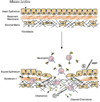Metalloproteinases and their inhibitors: regulators of wound healing
- PMID: 18083622
- PMCID: PMC2746915
- DOI: 10.1016/j.biocel.2007.10.024
Metalloproteinases and their inhibitors: regulators of wound healing
Abstract
Wound healing is a dynamic process that involves a coordinated response of many cell types representing distinct tissue compartments and is fundamentally similar among tissue types. Among the many gene products that are essential for restoration of normal tissue architecture, several members of the matrix metalloproteinase (MMP) family function as positive and, at times, negative regulators of repair processes. MMPs were initially thought to only function in the resolution phase of wound healing, particularly during scar resorption; however, recent evidence suggests that they also influence other wound-healing responses, such as inflammation and re-epithelialization. In this review, we discuss what is currently known about the function of MMPs in wound healing and will provide suggestions for future research directions.
Figures

References
-
- Amour A, Knight CG, Webster A, Slocombe PM, Stephens PE, Knauper V, et al. The in vitro activity of ADAM-10 is inhibited by TIMP-1 and TIMP-3. FEBS Lett. 2000;473(3):275–279. - PubMed
-
- Amour A, Slocombe PM, Webster A, Butler M, Knight CG, Smith BJ, et al. TNF-alpha converting enzyme (TACE) is inhibited by TIMP-3. FEBS Lett. 1998;435(1):39–44. - PubMed
-
- Atkinson JJ, Toennies HM, Holmbeck K, Senior RM. Membrane-type 1 Matrix Metalloproteinase Is Necessary for Distal Airway Epithelial Repair and Keratinocyte Growth Factor Receptor Expression after Acute Injury. Am J Physiol Lung Cell Mol Physiol. 2007 - PubMed
Publication types
MeSH terms
Substances
Grants and funding
LinkOut - more resources
Full Text Sources
Other Literature Sources
Medical

